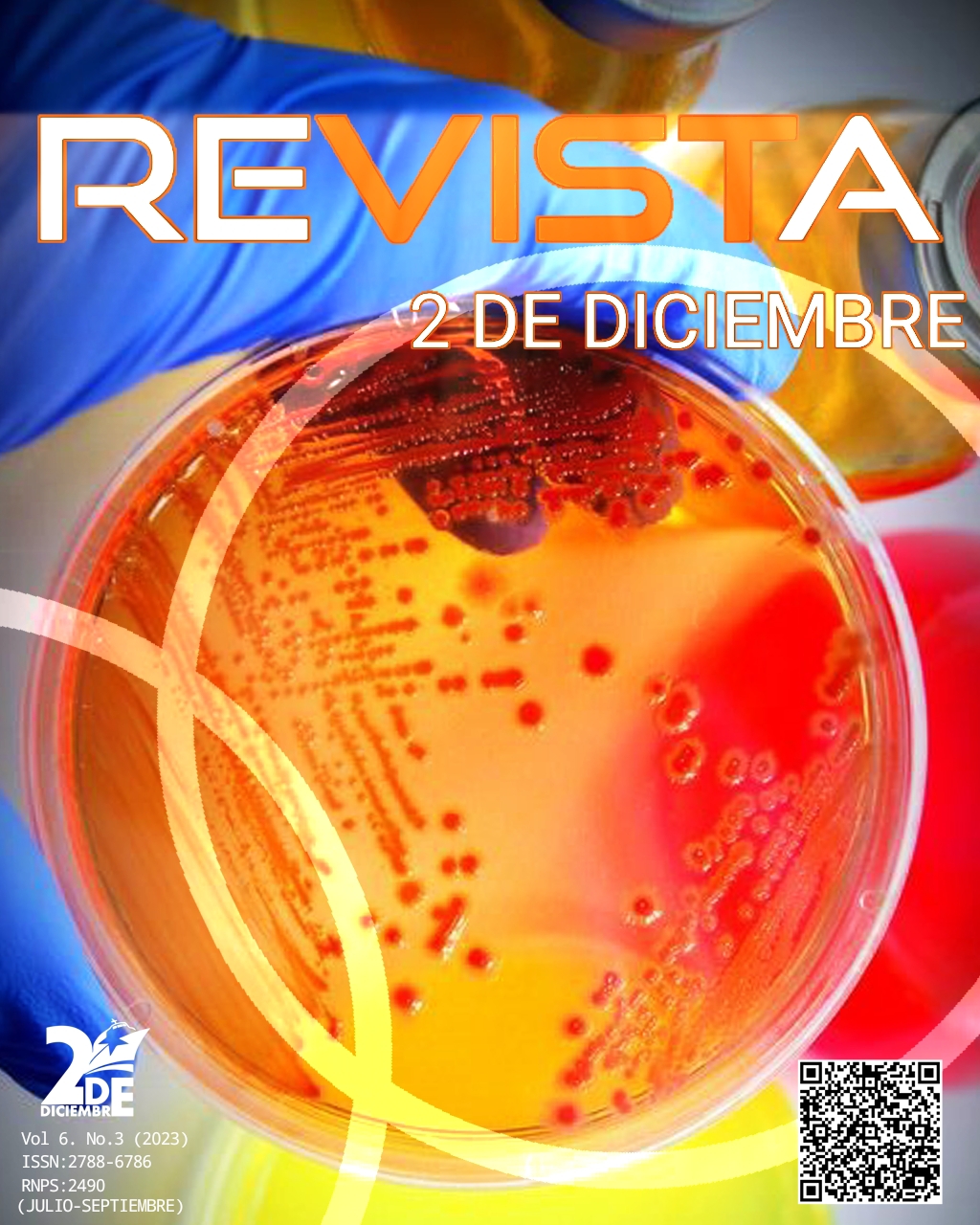Antimicrobial resistance of bacteria isolated in blood cultures performet at the Aleida Fernandez Hospital, Mayabeque, 2022
Keywords:
Blood Culture, Drug Resistence, Microbial, StaphylococcusAbstract
Introduction: bloodstream infections are an important cause of mortality worldwide. Using incorrect empiric therapies results in increases in antimicrobial resistance and deteriorating prognosis. The test of choice to identify these microorganisms that cause disease in the bloodstream is the blood culture. It is performed when there is suspicion of an infectious process or the need to identify the microorganism that causes the infection. The probability that the result of positive blood cultures represents a true bacteremia increases when the sample is obtained with a good technique; false positives lead to the inappropriate use of antibiotics. Objective: to characterize the blood culture samples processed in the microbiology laboratory of the Teaching-Clinical-Surgical Hospital Aleida Fernandez Chardiet. Methods: an observational descriptive cross-sectional study of 407 blood culture samples was carried out, collected and processed in the period from January to December 2022, in the microbiology laboratory of the Teaching-Clinical-Surgical Hospital. "Aleida Fernandez Chardiet" from Mayabeque, Cuba. Results: 19.41% of the blood samples were positive in the blood culture of These are the Nephrology services and the Care Unit Intensive were the ones that added the most positives. There was a great infection by gram-positive microorganisms, with a higher frequency of coagulase-negative Staphylococcus with 38%. Conclusions: it was found that the frequency of isolation in blood culture samples was low. The microorganisms that were isolated showed great resistance to beta-lactam antibiotics.
Downloads
References
Sierra J, Díaz MV, García MJ, Finello M, Suasnabar DF, Richetta L, et at. Infecciones del torrente sanguíneo en pacientes oncológicos. Medicina (B.Aires) [Internet]. 2020 [citado el 22 de febrero del 2023]; 80: 329-338. Disponible en: https://www.medicinabuenosaires.com/revistas/vol80-20/n4/329.pdf
Rubio Díaz R, Nieto Rojas I, Julián-Jiménez A. Importancia de los resultados de los hemocultivos: especial atención para los solicitados desde los Servicios de Urgencias. Rev Esp Quimioter [Internet]. 2020 [citado el 22 de febrero del 2023]; 33 (6): 459-461. Disponible en: https://www.ncbi.nih.gov/pmc/articles/PMC7712340/
Barrera-Toledo JC, Melgar S, Oregón E. Diseño, estandarización e implementación de una nueva técnica en Guatemala para el diagnóstico rápido de hemocultivos positivos, utilizando la tecnología Maldi-tof. Ciencia, Tecnología y Salud [Internet]. 2021 [citado el 22 de febrero del 2023]; 8 (1): 93-103. Disponible en: https://revistas.usac.edu.gt/index.php/cytes/article/view/905/779
Hernández Bou S, Trenchs Sainz de la Maza V, Esquivel Ojeda JN, Gené Giralt A, Luaces Cubells C. Factores predictores de contaminnnación ante un hemocultivo con crecimiento bacteriano en urgencia. An Pediatr [Internet]. 2015 [citado el 2 de diciembre del 2023]; 82 (6): 426-432. Disponible en: https://www.analesdepediatria.org/index.php?p=revista&tipo=pdf-simple&pii=S169540331400397X
Valdés C. Monserrat, González M. Belén, Gambi R. Giancarla, Piñera M. Cecilia. Bacterias aisladas positivas en hemocultivos en niños menores de 90 días ingresados por fiebre en el Hospital Exequiel González Cortés entre 2014 y 2016. Rev. chil. infectol. [Internet]. 2022 [citado el 2 de diciembre de 2023]; 39(2): 126-131. Disponible en: http://www.scielo.cl/scielo.php?script=sci_arttext&pid=S0716-10182022000200126&lng=en.
Abreu Pereira LM, Tarife Romero IE. Resistencia a los antimicrobianos del citrobacter freundii en hemocultivos. Inmedsur [Internet]. 2023 [citado el 2 de diciembre de 2023];6(2): e237. Disponible en: https://www.inmedsur.cfg.sld.cu/index.php/inmedsur/article/download/237/225
Sosa-Campos JM, Sosa-Flores JL, Ferrari-Maurtua JB, Chapoñan-Mendoza JF, Sandoval-Torres G. Resistencia antibiótica de bacterias aisladas en hemocultivos y urocultivos en niños hospitalizados. Hospital Nacional Almanzor Aguinaga Asenjo 2017-2018. Rev. Cuerpo Med. HNAAA [Internet]. 2021 [citado el 22 de febrero del 2023]; 14 (1): 8-12. Disponible en: http://www.scielo.org.pe/pdf/rcmhnaaa/v14n1/2227-4731-rcmhnaaa-14-01-8.pdf
Rodríguez Pérez M. Hemocultivos en el Instituto de Hematología e Inmunología: optimizando la toma de muestra. Rev Cubana Hematol Inmunol Hemoter [Internet]. 2021 [citado el 22 de febrero del 2023]; 37 (4): e1501. Disponible en: https://revhematologia.sld.cu/index.php/hih/article/download/1501/1207
Noriega Campos E, Milanés Hernández AM, Dreke Fernández R. Nivel de conocimiento sobre la extracción de hemocultivos en enfermeras de la Unidad de Cuidados Intensivos. Rev Cubana Enfermer [Internet]. 2022 [citado el 22 de febrero del 2023]; 38 (1): e4533. Disponible en: https://revenfermeria.sld.cu/index.php/enf/article/download/4533/821
Milá-Pascual MC, Campos-Bestard I, Torres-Milá I, Aties-López L. Hemocultivos de pacientes ingresados en el Hospital Clínico Quirúrgico Dr. Ambrosio Grillo Portuondo, Santiago de Cuba. Rev. Electrón. Dr. Zoilo E. Marinello Vidaurreta [Internet]. 2021 [citado el 22 de febrero del 2023]; 46 (1). Disponible en: https://revzoilomarinello.sld.cu/index.php/zmv/article/download/2480/pdf_756
Callejas-Díaz A, Calderón-Parra J, Fernández-Cruz A. Hemocultivos: indicaciones e interpretación. Protocolos de práctica asistencial [Internet]. 2022 [citado el 22 de febrero del 2023]; 13 (50): 2956-9. Disponible en: https://www.binasss.sa.cr/medint/20.pdf
Cayo Castillo JJ, Cuaresma Cuadros EA. Tendencia del perfil de sensibilidad microbiana de los aislamientos de hemocultivos en un hospital de tercer nivel. Rev Med Basadrina [Internet]. 2022 [citado el 24 de febrero del 2023];? 16(2):31-36. Disponible en: http://www.revistas.unjbg.edu.pe/index.php/rmb/article/download/1552/1780
Valdés M, González B, Gambi G, Piñera C. Bacterias aisladas en hemocultivos positivos en lactantes bajo 90 días de edad ingresados por fiebre al Hospital Exequiel González Cortés entre 2014 y 2016. Rev. chil. infectol. [Internet]. 2022 [citado el 23 de febrero del 2023]; 39 (2): 126-131. Disponible en: https://www.scielo.cl/pdf/rci/v39n2/0716-1018-rci-39-02-0126.pdf
Duran-Lengua M, Valladales-Restrepo L, Caraballo-Marimón R, Romero Martínez G, Cabarcas-Tovar A, Bohórquez Moreno C. Prevalencia de resistencia de bacterias aisladas en hemocultivos, en un hospital universitario de Colombia. Nova [Internet]. 2021 [citado el 23 de febrero del 2023]; 19 (37): 57-69. Disponible en: http://www.scielo.org.co/pdf/nova/v19n37/1794-2470-nova-19-37-57.pdf
Dopico-Ravelo D, Rodríguez-González A, Hernández-Suárez N, Junco-Labrador L, Cuello-Carballo MB. Hemocultivo como medio para establecer el mapa microbiológico en la neumonía adquirida en la comunidad. Rev. Cienc. méd. Pinar Río [Internet]. 2022 [citado el 23 de febrero del 2023]; 26 (6): e5360. Disponible en: https://revcmpinar.sld.cu/index.php/publicaciones/article/view/5360/4937
Guerreo Pardo C, Torres Martínez LR, Diez Monterdes MT, Marzán De la Rosa AD, López Rengifo MJ, Figueredo Acosta I. Agentes bacterianos causantes de bacteriemia. Hospital Provincial Clínico Quirúrgico Saturdino Lora Torres. Cuba Salud 2022 [Internet]. 2022 [citado el 24 de febrero del 2023]. Disponible en: https://convencionsalud.sld.cu/index.php/convencionsalud22/2022/paper/download/948/315
Hernández-Torres A, García-Gómez A, Pradere-Pensado J, Adela-Rives Y, Fernández-Castillo E. Bacteriemias en la Unidad de Cuidados Intensivos. Rev. Cuba. de Medicina Mil [Internet]. 2019 [citado el 24 de febrero del 2023]; 48 (1): [Aprox.10p.].Disponible en: https://revmedmilitar.sld.cu/index.php/mil/article/view/242
Sanmartín Orbe ML, Andrande Tacuri CF, Orellana Bravo PP. Susceptibilidad de las cepas de S. aureus aisladas en superficies hospitalarias. Vive Rev. Salud [Internet]. 2021 [citado el 5 de febrero del 2023];? 4(11):233-245. Disponible en: http://www.scielo.org.bo/pdf/vrs/v4n11/2664-3243-vrs-4-11-233.pdf
Ortega-Peña S, Franco-Cendejas R, Salazar-Sáenz B, Rodríguez-Martínez S, Cancino-Díaz ME, Cancino-Díaz JC. Prevalencia y factores de virulencia de Staphylococcus coagulasa negativos causantes de infección de prótesis articular en un hospital ortopédico de México. Cir. Cir. [Internet]. 2021 [citado el 5 de febrero del 2023];? 87(4):428-425. Disponible en: https://www.scielo.org.mx/pdf/cicr/v87n4/2444-054X-cir-87-4-428.pdf
Ullauri-González C, Freire-Cuesta S. Citrobacter freundii multirresistente como agente etiológico de infección de vías urinarias. Kasmera [Internet]. 2019 [citado el 5 de febrero del 2023];? 47 (1):09-13. Disponible en: https://www.redalyc.org/journal/3730/373061540003/htm/
García-Henao JP, García-Ríos JM, Naranjo-Arango YA, Grajales-Rojas J, Vinasco-Sánchez LG. Uso de antibióticos y resistencia antimicrobiana en la unidad de cuidados intensivos neonatal. Rev. Med. Risaralda [Internet]. 2021 [citado el 5 de febrero del 2023];? 27 (2):102-125. Disponible en: http://www.scielo.org.co/scielo.php?script=sci_arttext&pid=S0122-06672021000200102
Downloads
Published
How to Cite
Issue
Section
License
Authors who have publications with this journal agree to the following terms: authors retain their copyright and grant the journal the right of first publication of their work, which is simultaneously subject to the Creative Commons Attribution-NonCommercial 4.0 International License that allows third parties to share the work as long as the author and first publication in this journal are indicated, for non-commercial use. Authors may adopt other non-exclusive license agreements for distribution of the published version of the work (e.g., depositing it in an institutional telematic archive or publishing it in a monographic volume) as long as the initial publication in this journal is indicated. Authors are allowed and encouraged to disseminate their work via the Internet (e.g., in institutional telematic archives, in their web page or in Pre-print servers) before and during the submission process, which can lead to interesting exchanges and increase citations of the published work. (See The Open Access Effect).







